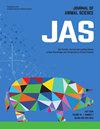Insulin-sensitizing effects of fibroblast growth factor-21 in underfed sheep
IF 2.7
2区 农林科学
Q1 AGRICULTURE, DAIRY & ANIMAL SCIENCE
引用次数: 0
Abstract
Reversal of insulin resistance by fibroblast growth factor-21(FGF21) in rodent and non-human primate models of obesity and in well-fed sheep was associated with increased production of the insulin-sensitizing hormone adiponectin. In contrast, FGF21 therapy failed to increase plasma adiponectin and improve insulin action in energy-deficient ruminants facing metabolically demanding states such as early lactation dairy cows. The goal of the study was to test the hypothesis that FGF21 is unable to improve insulin action in energy-deficient ruminants as a consequence of its failure to increase plasma adiponectin. Non-pregnant, non-lactating ewes were treated for 12 days with FGF21 or excipient when well-fed (WF; 2-fold of maintenance energy requirement, n=4) or underfed (UF; 0.5-fold of maintenance energy requirement, n=4). Plasma variables were measured as indices of insulin action (glucose, insulin and adiponectin), lipolysis (fatty acids), and ketogenesis (β-hydroxybutyrate) on day 1, 4, 7, 10, and 12 of treatment. The effect of treatments on insulin action was assessed by measuring glucose disposal during insulin tolerance tests on day 10 and glucose tolerance tests on day 11. Quantitative RT-PCR was used to measure expression of genes mediating FGF21 effects in adipose tissue. Underfed ewes lost weight (EB, P < 0.01) and had reduced plasma glucose (EB, P = 0.04) and insulin (EB × Day, P = 0.01), confirming negative energy balance. In UF ewes, FGF21 retained the ability to reduce plasma glucose (FGF21, P = 0.02) but not plasma insulin. FGF21 improved insulin action in both WF and UF ewes during glucose (insulin response area; FGF21, P = 0.02) and insulin tolerance tests (FGF21, P = 0.04) and did so in the absence of increased plasma adiponectin in UF ewes. Underfeeding reduced adipose tissue expression of the FGF21 co-receptor β-Klotho (EB, P < 0.01) and attenuated FGF21 stimulation of the FGF-responsive genes SPRY4 (EB × FGF21, P = 0.07) and DUSP4 (EB × FGF21, P = 0.02). FGF21 failed to increase adiponectin mRNA expression at both feeding levels. FGF21 had no effect on plasma fatty acids but reduced plasma β-hydroxybutyrate in UF ewes (EB × FGF21, P = 0.02). These data show that energy insufficiency alone does not prevent FGF21 improvement of insulin action in ruminants and that increased adiponectin production is not necessary for FGF21 insulin-sensitizing effects.成纤维细胞生长因子-21在营养不良绵羊中的胰岛素增敏作用
在啮齿类动物和非人类灵长类动物肥胖模型中,成纤维细胞生长因子-21(FGF21)对胰岛素抵抗的逆转与胰岛素增敏激素脂联素的产生增加有关。相比之下,FGF21治疗未能提高处于代谢需求状态的能量缺乏反刍动物(如早期泌乳奶牛)的血浆脂联素和胰岛素作用。该研究的目的是验证FGF21不能改善能量缺乏反刍动物胰岛素作用的假设,因为它不能增加血浆脂联素。未怀孕、未哺乳的母羊在喂饱的情况下用FGF21或赋形剂治疗12天(WF;维持能量需求的2倍,n=4)或供能不足(UF;维持能量需求的0.5倍,n=4)。在治疗的第1、4、7、10和12天,测量血浆变量作为胰岛素作用(葡萄糖、胰岛素和脂联素)、脂肪分解(脂肪酸)和生酮(β-羟基丁酸)的指标。在第10天的胰岛素耐量试验和第11天的葡萄糖耐量试验中,通过测量葡萄糖处理来评估治疗对胰岛素作用的影响。采用定量RT-PCR检测脂肪组织中介导FGF21作用的基因表达。喂养不足的母羊体重下降(EB, P <;0.01),血糖(EB, P = 0.04)和胰岛素(EB × Day, P = 0.01)降低,证实能量负平衡。在UF母羊中,FGF21保留了降低血糖的能力(FGF21, P = 0.02),但没有降低血浆胰岛素的能力。FGF21改善了WF和UF母羊在葡萄糖胰岛素反应区的胰岛素作用;FGF21, P = 0.02)和胰岛素耐量试验(FGF21, P = 0.04),并且在UF母羊血浆脂联素未升高的情况下进行。摄食不足降低脂肪组织中FGF21共受体β-Klotho的表达(EB, P <;FGF21对FGF21应答基因SPRY4 (EB × FGF21, P = 0.07)和DUSP4 (EB × FGF21, P = 0.02)的刺激减弱。两种饲喂水平下,FGF21均未能提高脂联素mRNA的表达。FGF21对UF母羊血浆脂肪酸没有影响,但降低了血浆β-羟基丁酸(EB × FGF21, P = 0.02)。这些数据表明,能量不足本身并不能阻止FGF21对反刍动物胰岛素作用的改善,并且脂肪联素的增加并不是FGF21胰岛素增敏作用的必要条件。
本文章由计算机程序翻译,如有差异,请以英文原文为准。
求助全文
约1分钟内获得全文
求助全文
来源期刊

Journal of animal science
农林科学-奶制品与动物科学
CiteScore
4.80
自引率
12.10%
发文量
1589
审稿时长
3 months
期刊介绍:
The Journal of Animal Science (JAS) is the premier journal for animal science and serves as the leading source of new knowledge and perspective in this area. JAS publishes more than 500 fully reviewed research articles, invited reviews, technical notes, and letters to the editor each year.
Articles published in JAS encompass a broad range of research topics in animal production and fundamental aspects of genetics, nutrition, physiology, and preparation and utilization of animal products. Articles typically report research with beef cattle, companion animals, goats, horses, pigs, and sheep; however, studies involving other farm animals, aquatic and wildlife species, and laboratory animal species that address fundamental questions related to livestock and companion animal biology will be considered for publication.
 求助内容:
求助内容: 应助结果提醒方式:
应助结果提醒方式:


